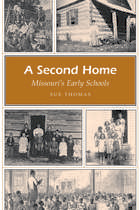
The one-room schoolhouse may be a thing of the past, but it is the foundation on which modern education rests. Sue Thomas now traces the progress of early education in Missouri, demonstrating how important early schools were in taming the frontier.
A Second Home offers an in-depth and entertaining look at education in the days when pioneers had to postpone schooling for their children until they could provide shelter for their families and clear their fields for crops, while well-to-do families employed tutors or sent their children back east. Thomas tells of the earliest known English school at the Ramsay settlement near Cape Girardeau, then of the opening of a handful of schools around the time of the Louisiana Purchase—such as Benjamin Johnson’s school on Sandy Creek, Christopher Schewe’s school for boys when St. Louis was still a village, and the Ste. Genevieve Academy, where poor and Indian children were taught free of charge. She describes how, as communities grew, additional private schools opened—including “dame schools,” denominational schools, and subscription schools—until public education came into its own in the 1850s.
Drawing on oral histories collected throughout the state, as well as private diaries and archival research, the book is full of firsthand accounts of what education once was like—including descriptions of the furnishings, teaching methods, and school-day activities in one-room log schools. It also includes the experiences of former slaves and free blacks following the Civil War when they were newly entitled to public education, with discussions of the contributions of John Berry Meachum, James Milton Turner, and other African American leaders.
With its remembrances of simpler times, A Second Home tells of community gatherings in country schools and events such as taffy pulls and spelling bees, and offers tales of stern teachers, student pranks, and schoolyard games. Accompanying illustrations illuminate family and school life in the colonial, territorial, early statehood, and post-Civil War periods. For readers who recall older family members’ accounts or who are simply fascinated by the past, this is a book that will conjure images of a bygone time while opening a new window on Missouri history.

As orphan asylums ceased to exist in the late twentieth century, interest in them dwindled as well. Yet, from the Civil War to the Great Depression, America's dependent children--children whose families were unable to care for them--received more aid from orphan asylums than from any other means. This important omission in the growing literature on poverty in America is addressed in Second Home.
As Timothy Hacsi shows, most children in nineteenth-century orphan asylums were "half-orphans," children with one living parent who was unable to provide for them. The asylums spread widely and endured because different groups--churches, ethnic communities, charitable organizations, fraternal societies, and local and state governments--could adapt them to their own purposes.
In the 1890s, critics began to argue that asylums were overcrowded and impersonal. By 1909, advocates called for aid to destitute mothers, and argued that asylums should be a last resort, for short-term care only. Yet orphanages continued to care for most dependent children until the depression strained asylum budgets and federally-funded home care became more widely available. Yet some, Catholic asylums in particular, cared for poor children into the 1950s and 1960s.
At a time when the American welfare state has failed to provide for all needy children, understanding our history in this area could be an important step toward correcting that failure.
READERS
Browse our collection.
PUBLISHERS
See BiblioVault's publisher services.
STUDENT SERVICES
Files for college accessibility offices.
UChicago Accessibility Resources
home | accessibility | search | about | contact us
BiblioVault ® 2001 - 2024
The University of Chicago Press









